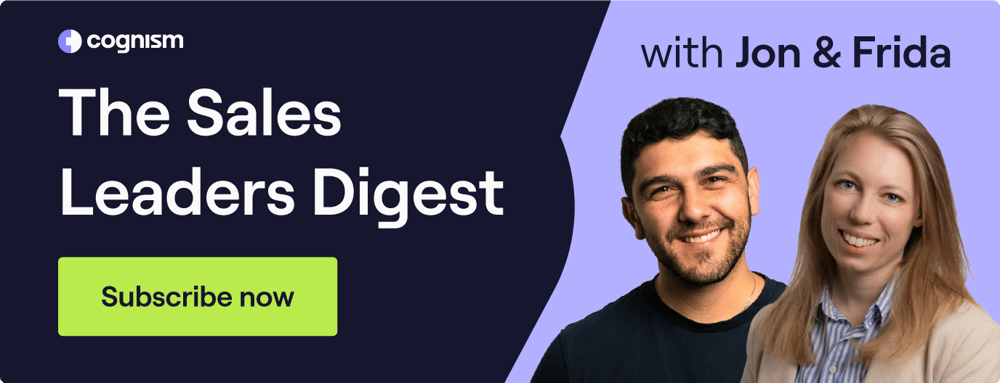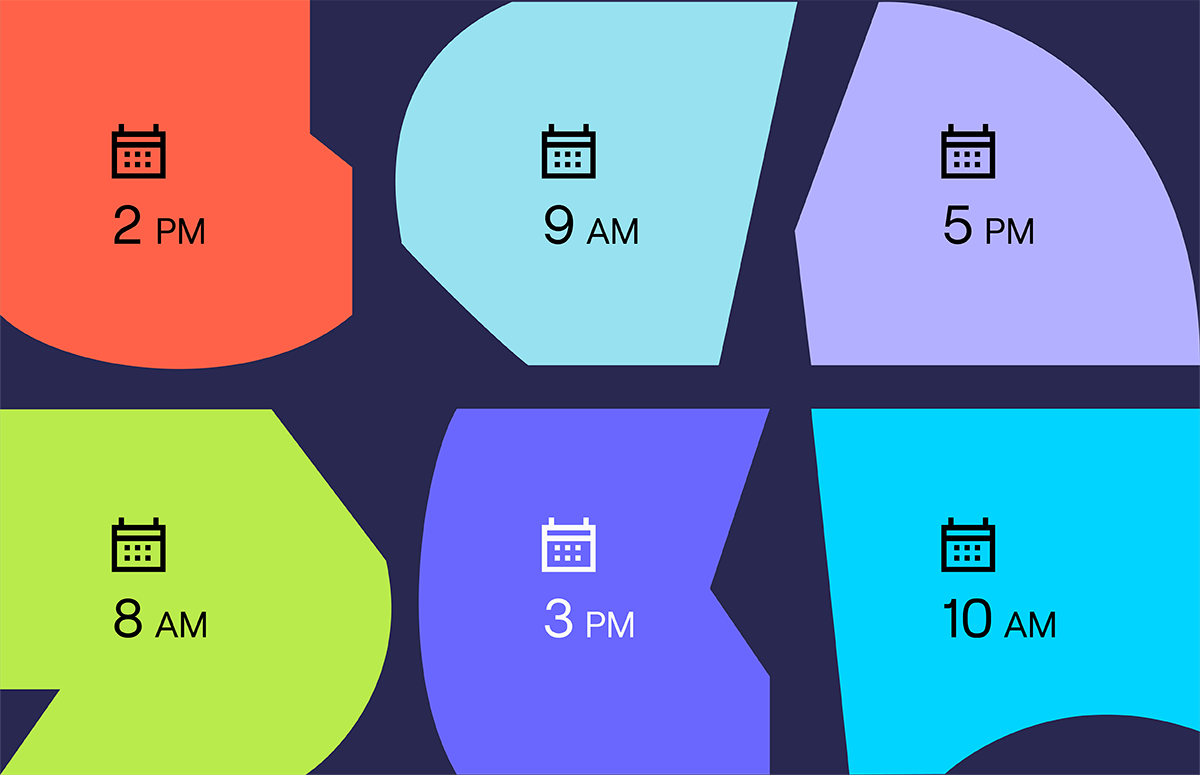How to Hire and Train Outbound Teams for Scalable Success
Time for a reality check.
When it comes to hiring and onboarding an outbound team. It’s a sales leader’s responsibility to put in real time and effort.
If this intent isn’t there, outbound teams are set up to fail. Because you can’t just throw headcount at the revenue number and hope for the best.
Yes - there’s such a thing as learning on the job. But it’s also important not to take things to the extreme.
It’s vital for sales leaders to provide learning and space for your SDRs to get to grips before their role kicks in.
This is especially important for outbound teams that need to scale. You need to create repeatable processes. Think of it as the positive domino effect.
In this post, we look at the best ways for sales leaders to hire, train, and onboard their outbound functions.
And how to approach the process in such a way that it becomes scalable.
We’ve featured insights from:
- David Bentham, Cognism’s Director of Sales Development.
- Thomas Allcock, Cognism’s Enterprise Sales Manager.
- Ashleigh Early, CEO of The Other Side of Sales and Trainer at WinningByDesign.
- Gabrielle Blackwell, SDR Manager at Airtable.
- Sales expert Morgan J. Ingram.
Scroll to uncover more.👇
Why is it important to invest time into hiring and onboarding outbound reps?
‘How many reps do we need to ramp up now, to reach our number today?’
This is a common trap many sales leaders fall into. Looking at the short-term rather than the long-term.
Now, here’s the thing.
With this approach, you’re likely to see your team hitting numbers today or even tomorrow.
But if you rush your hiring and onboarding process, you won’t meet your long-run revenue number. Even if that’s in 3, 6 or 12 months’ time.
If you create an unsustainable process, you won’t be able to iterate it again, and again.
Gabrielle explained why it’s crucial to put real thought into hiring and onboarding:
“Leaders need to ask themselves questions like:
- Who do we need to be hiring?
- What does the hiring profile look like?
Understanding internally the people you need to work with is going to help develop a process to get the right people in seats.”
What should sales leaders look for when hiring for outbound during a period of scaling?
What does it mean to hire the right people?
Well, there are two factors that leaders need to consider:
- The diversity of the pool of candidates.
- Specific qualities that are going to help the outbound function to scale.
Have a diverse approach
Ashleigh said:
“You need the widest possible applicant pool to interview from."
"So make sure the first contact, from job posting all the way to onboarding, is set up to serve a wide range of people. Because your prospects come from a wide range of life experiences.”
She said that it comes down to hiring with a mindset geared towards diversity and inclusion:
“Review your benefits as part of the job description audit. For example, if we’re talking about the US, not including paid familial [maternity/paternity leave] is not okay. Not in today’s market.”
She added:
“Even people who don’t have children are still looking at that. Because it’s an indicator of how serious you are when it comes to taking care of your employees.”
Now, what else can sales leaders do? Well, Ashleigh said there’s great power in sourcing talent from LinkedIn groups:
“There are tonnes of groups supporting minority groups in sales. Reach out to them and ask for their advice. Lean into those and leverage them. A lot of it is going to be referral and trust base.”
You can also source candidates using tools for recruiters to automate, simplify, and make the hiring process more efficient.
Now, how is this all relevant for scaling outbound?
Well, this mindset will enable you - the sales leader, to hire good reps.
Good reps mean successful activity. And successful outbound means a positive scalable impact.
Think about specific qualities you’re looking for
For sales leaders looking to scale their enterprise outbound teams, Tom gave the following advice.
Firstly, hiring fast learners was essential for his team:
“Internal promotions are preferable when it comes to enterprise. Because of the familiarity, the pace at which reps can pick things up will be quicker.”
“But if you choose to hire an external candidate, you’ll want people who can hit the ground running. That’s because there are a lot of different levers when it comes to enterprise sales cycles. So hiring someone who’s had exposure before is also a win.”
Tom also said it’s important to hire reps that will have an open mindset:
“Yes - a willingness to win is important. But I also look for reps that are open to coaching and feedback. Even if they’re crushing numbers every month.”
“I hire with this mindset, so I can allow reps to go from strength to strength. Setting these expectations from the very start means that they become ingrained. And that’ll help create a positive domino effect when scaling the team from one stage to the next.”
Morgan agreed. When you’re hiring, if you only focus on reaching numbers it can have implications later on. Particularly when it comes to scaling.:
“Leaders tend to keep toxic people around because they’re helping with revenue."
"But here’s the thing. Keeping someone there who is negative has a way worse impact."
"Because if everyone else in the team feels bogged down because of one person, you’ll lose people in general.”
What are the risks of hiring too fast during a period of scaling outbound?
You don’t need to throw headcount when scaling outbound.
This is a myth.
And if you’re too ambitious, and try and hire a bunch of reps in a short time span, you’re set up to fail.
If you move too fast, quality control can become an issue in the hiring process. Dave explains why in the clip below.
Morgan agreed, saying:
“A lot of the time, people higher up in the company will see ‘X’ amount of funding. But they don’t make appropriate estimations.”
“Sales leaders need to take a step back and ask themselves: ‘Can we be successful without lots of reps? And can we prove a framework along the way?’”
He summarised the damage that hiring too fast can have on outbound teams:
“The reality is that hiring too fast will spread you too thinly. And that means gaps in coaching and training. And that’ll mean a high risk of turnover because you don’t have the right processes in order.”
What does the ideal coaching process look like for outbound?
This can seem like a loaded topic.
And if you’re a sales leader who is building or scaling an outbound team for the first time, it can be a daunting task. Onboarding portals can help get candidates up to speed but don’t forget about the human approach.
Here are a couple of pointers that our interviewees placed an emphasis on.👇
Have a clear structure
This has been one of Ashleigh’s passion projects.
She sees coaching, onboarding, and training split into three categories:
- Independent work
- Shadowing
- Classwork
“There’s a science behind it. Adults learn differently from kids. Roughly 10% is learnt in a classroom, 20% is learnt by watching others, and 70% is actually doing the activity.”
“There’s a system called a flipped classroom. This means that the rep does everything they’re going to do in class, before the class. Then, once the rep is in the session, they can put it into practice under guided supervision. That’s the second time the rep has accessed the information. And then when they actually go and do it, that’s three hits in one week.”
Now, why bother with this approach?
“This is a much more effective [technique] for sticking in reps’ minds. Compared to only being in the classroom and having to action [the information] at some point down the road.”
She added:
“I find that when you have the day as a three-way split between these pillars, reps don’t get bored or overloaded. Classroom sessions are super intense. But during independent work, you have to focus but can knock things out. Whereas shadowing is a little more chilled out because you’re sitting back and absorbing.”
It’s fair to say there’s a lot of effort behind this activity. So we wanted to know why it enables leaders to scale outbound the right way.
Ashleigh said:
“There are sales leaders who take the view of: ‘I didn’t have any processes when I was a rep, and I came out fine.’ Okay - great. The old system worked for you. But not everyone is like you.”
“This is part of the reason why diversity, equity, and inclusion are such a problem in sales. If you build a system with people who can only succeed if they’re like you, this isn’t scalable. And you’re not going to get the best talent possible.”
Morgan shared this view:
“The biggest problem that leaders have is that they are way too focused on what they did to be successful. Instead of what they need to do to coach the rep to be successful.”
“Other people aren’t [the same as] you. And it’s important to focus on proactive communication. Talk to reps and understand what’s going on. Don’t just assume they’ll learn in the same way as you.”
To that end, Ashleigh reminds us that not everyone learns in the same way, so document what you’re doing:
“When I’m designing curriculums for companies who are onboarding new reps from scratch, it’s about building the learning management system."
'Considering the exact skills reps need to learn, and how they’re doing the learning. For example, will they watch a video? Or fill out a worksheet? And I encourage leaders to keep all of this information in a place somewhere, like a binder.”
Dave has also shared this view
Consider the industry size being targeted
Thomas Allcock offered how processes around teaching operate in his enterprise sales team:
“I run workshops or bespoke 1-2-1s on the account mapping process. I test reps’ knowledge of our existing customer base.”
He stressed:
“In enterprise, it’s overwhelming so you can’t just throw reps to the wolves. Salespeople contact enterprises on so many different levels, for many different products."
"When it comes to coaching, encouraging resilience is vital. There are longer sales cycles, and setting realistic expectations for reps is important. For example, remind your reps not to worry if things aren’t coming in two months.”
How should sales leaders approach tech stack training for reps?
Getting to grips with the tech stack can be overwhelming for outbound reps when they start.
And part of the reason is that there’s so much that you can do with the software - beyond the basics.
So when it comes to the tech aspect of the role, what should the criteria of a repeatable training approach be?
Gabrielle shared the cadence and expectations from her SDRs at Airtable:
“Let’s think about the first two weeks of the gig. After these two weeks, I want reps to be able to do certain things. For example, know how to add prospects into a sequence or find people on LinkedIn Sales Navigator. At this stage, it’s important to know the fundamentals. So that the rep is ready from a workflow and system level.”
We wanted to know. Do software updates have an impact on Gabrielle’s training method? She explained:
“It depends on what the update is, and the usability of that new feature. I encourage myself to think about whether it’s going to make my reps more efficient. For example, move quickly from one task to the next.”
She even explained what this means in practice:
“For example, we’re having a lot of success in this one channel. But it takes us a long time to get there. But this new software feature means we can get there faster.”
The bottom line?
Focus on productivity. Don’t confuse your reps with shiny new features if it’s not going to help your outbound function as a whole.
Closing thoughts
It’s fair to say that hiring and onboarding outbound well takes time and effort.
In other words, you can’t just hire a bunch of reps tomorrow, and expect to hit your numbers.
Gabrielle said:
“The shift from an inbound to an outbound model is a huge one. And I mean from a mental, cultural and process perspective.”
So, what aspects should leaders prioritise when it comes to hiring and onboarding when scaling outbound, over the next year or so?
Gabrielle said:
“Think about the career path for your SDR. Do you see them as a potential leader one day? Yes - granted. You might not have to think about it straight away. But if they’re performing well, they may accelerate in the role quicker than expected.”
The key takeaway here?
Think ahead, and realise the potential of the rep beyond their current role. Consider promotions or title changes. And how they’re going to get there.
For Tom, it’s important to consider benefits packages that companies are going to set up:
“There’s great talent out there. So when you’re scaling, make sure you’re offering competitive packages. And remember to introduce an uplift for existing reps too. Do a regular salary review to make sure you’re attracting and keeping the best talent.”
He summarised the importance of this:
“It all comes back to the compounding effect. The more effort leaders put in at the beginning, the more the success of the scaled outbound function will speak for itself.”
Hit play for tips for sales enablement success in episode 72 of Revenue Champions. 🏆
Get more sales insights
If you’re interested in learning more sales insights, sign up for the Sales Digest below.



